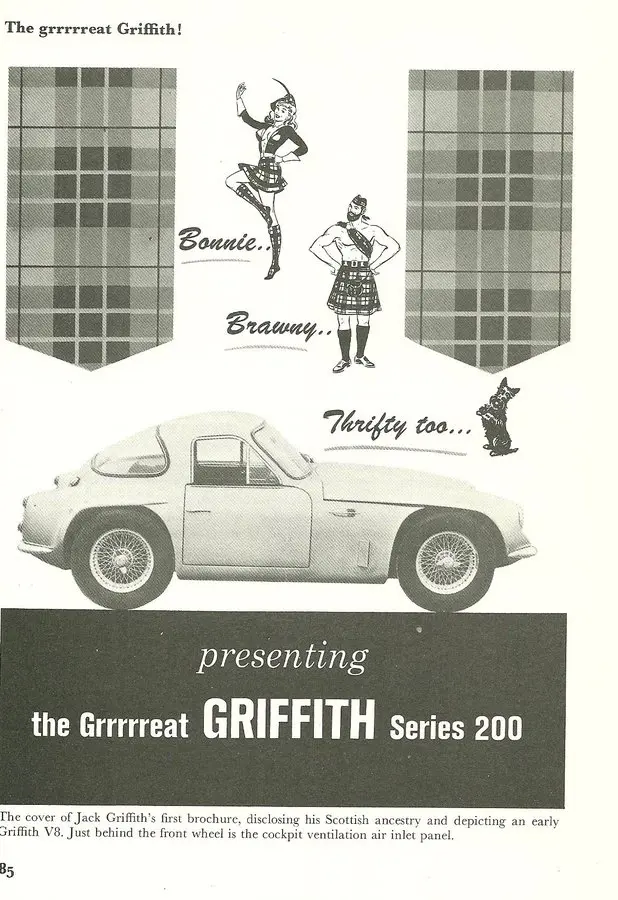THE REMARKABLE TVR GRIFFITH 200
25 July 2023
"You dreamed it...we built it". That was the marketing slogan for the remarkable blend of the TVR Grantura Mk. III with a 4,727cc Ford V8 engine known as the Griffith 200.
The narrative starts in 1962, with the Long Island Ford dealer Andrew 'Jack' Griffith. He was also a 'Ford Performance' distributor and a Shelby Cobra franchisee tasked with collecting and storing AC Ace bodies before despatching them to California. As the story goes, one day in 1963, a local racer and TVR importer named Dick Monnich visited the workshop and his Grantura Mk. III greatly intrigued the proprietor. The owners' club https://www.tvr-car-club.co.uk/ also states:

“The North American racing driver and TVR USA importer Gerry Sagerman was having his personal race car, a Mk. III Grantura fettled in the workshop run by Jack Griffith at the same time as former TVR racer Mark Donohue was having his AC Cobra serviced there. Allegedly, Griffith's mechanics swapped the engines 'because they could', and although the transplant didn't quite work, Griffith liked the idea.”
Meanwhile, across the Atlantic, TVR was in financial difficulties. The halving of the Purchase Tax (PT) on new cars had severely impacted the kit-car market, which traditionally attracted owners who wished to avoid PT by home-building their vehicles. A new Anglo-American venture could provide fresh opportunities, and by March 1964, Ford granted permission for Griffith to install their 'Windsor' V8 engine into the Grantura.
TVR supplied the Griffith with fibreglass bodies fitted with steering, brakes and suspension, while the Detroit power plant and gearbox was installed in the USA. Of course, the Blackpool concern never intended the Grantura to have a 4.7-litre engine, so the bodyshell required considerable modifications. The chassis had main nine inches further apart, strengthened front suspension pick-up points and an altered lower tube cross member. Workers. even had to apply 16lb sledgehammers to the frame to assist with the installation process.
The price of a Griffith 200 was $3,995; the 289 engine in 271 bhp form cost another $495. Even the standard model was capable of a fairly startling 140 mph with 0-60 in six seconds, while the latter, according to the sales copy, could achieve 145 mph and 0-60 in 3.8 seconds.
The 200 was replaced by the 400 in November 1964. UK sales began in 1965, strangely under the name 'Griffith 200', and the October edition of Car tested the TVR opposite the Marcos 1800. The prices were £1,693 and £1,935, respectively, and the report concluded: "But speaking as simple, honest enthusiasts, the sheer oomph of the TVR Griffith 200 has an irresistible appeal".
In the same month, John Bolster tested 'Chassis No.1', which featured suspension and brakes modified for competition by Chris Lawrence Racing. The great writer reported in Autosport that this Griffith 200 was capable of 0-60 in 5.2 seconds and a top speed of 163 mph. In his view, "over 150 mph, things become somewhat fraught. One must either choose a still day or risk becoming one of Those Magnificent Men in Their Flying Machines". Chris Lawrence subsequently advertised it with the slogan, "This performance would cost £4,000 from any other source". Call FRObisher 4929 for more details.
Sadly, as the owners' club reports:
“A dock strike on the east coast of the USA in January 1965 cut off the supply of cars to Jack Griffith, and this resulted in the eventual collapse of both companies. TVR was rescued in November 1965 by Arthur and Martin Lilley, and a further ten TVR Griffith 200s were built from the stock left in the factory. The eleventh car built became the first SWB Tuscan.”
And while the Griffith 200 was destined to be an exclusive machine, it did anticipate future generations of TVRs. And, to quote Mr. Bolster, it was a "sheer delight".
